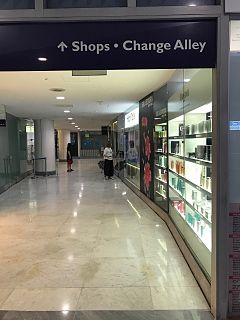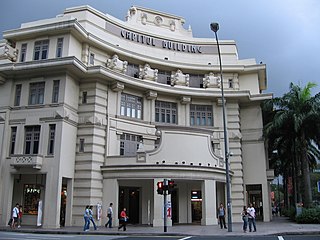
Kallang is a planning area and residential town located in the Central Region of Singapore.

The Labour Front was a major left-wing political party in Singapore that operated from 1955 to 1965.

GV Yishun, formerly Yishun 10, is Asia's first multiplex.

Change Alley is an air-conditioned shopping arcade flanked by 2 skyscrapers, Chevron House and Hitachi Tower, located in the financial district of Raffles Place in Downtown Core planning area of Singapore. It is an alley that links Raffles Place and Collyer Quay. It was renovated to what it is today in 1989, replacing the old Change Alley whose history dates back as far as 1819.

Capitol Building, formerly Shaws Building and Namazie Mansions, is a historic building at the junction of North Bridge Road and Stamford Road in the Downtown Core of Singapore. The building had since redeveloped along with adjoined Stamford House and both were reopened as a hotel The Capitol Kempinski Hotel Singapore in October 2018.

The National Centre for Infectious Diseases, previously known as the Communicable Disease Centre, is a national public health institute under the Ministry of Health of Singapore. Located next to Tan Tock Seng Hospital in Novena, all patients within the city-state who are affected with a highly contagious disease are also quarantined at the NCID and is used to control an outbreak of such diseases. The executive director of the hospital is Professor Yee-Sin Leo.

Masjid Al-Abdul Razak is a mosque in Singapore, located at Jalan Ismail, off Jalan Eunos. The mosque is accessible from Eunos MRT station.
Eng Wah Global, formerly Eng Wah Organisation and Eng Wah Theatres Organisation, is a Singaporean company spans entertainment, properties, hospitality, and lifestyle in Singapore and Malaysia.

Dover Court International School is an international school in Singapore. Founded in 1972, the school delivers the English National Curriculum and International Baccalaureate Diploma Program to 1650 students between the ages of 3 and 18. Over 60 nationalities are represented in the school, with the majority of teachers coming from the United Kingdom. In 2015, Dover Court International School registered with the Committee for Private Education of Singapore and since April 2014 has been part of the Nord Anglia Education group of schools.
East Coast Road is a two-way road in Marine Parade, Singapore. As its name suggests, the road used to run along Singapore's southeastern coastline before extensive land reclamation shifted the coastline southwards. The road started in the west as Mountbatten Road, then continuing eastwards after the junction with Haig Road and Amber Road as East Coast Road. Moving further eastwards, the road continues as Upper East Coast Road before making a turn northwards and continue as Bedok Road.

Rex Cinemas Mackenzie, formerly Rex Cinemas and Rex Theatre, is an Art Deco style cinema building in Singapore. the cinema was adjacent to Ellison building along Mackenzie Road. The cinema was bounded by major road, Bukit Timah Road and secondary roads Mackenzie and Selegie Road.

Istana Tyersall is a demolished historical palace that used to be located on the former Tyersall Park bound by Holland Road and Tyersall Road near the Singapore Botanic Gardens in Singapore. The land it was formerly built on is currently restricted from the public.

Johnston's Pier was a pier, formerly situated at Collyer Quay, Singapore, where it stood from the mid-1850s to the mid-1930s.

Capitol Theatre, briefly Kyo-Ei Gekijo, is a historic cinema and theatre located in Singapore. It was adjoined to four-storey building known as the Capitol Building. The Capitol Theatre was considered as one of the Singapore's finest theatres in the 1930s during that time.

Alkaff Gardens was a Japanese-style park once located east of the Bidadari Cemetery from 1930 to 1964, on the present site of Cedar Girls' Secondary School at Bidadari, Singapore. In the 1930s, the park was a popular leisure destination for dating couples and families. It featured as its centrepiece an artificial lake, which was drained in 1964.

The Keppel Hill Reservoir is an abandoned reservoir near the Mount Faber on the southern part of Singapore. It was built during the colonial period of Singapore. It fell into disuse due to its small capacity and was eventually forgotten. It was rediscovered in 2005.

Shaw Tower, also sometimes referred to as Shaw Towers, is a defunct high-rise commercial building located on Beach Road in Singapore. At the time of its completion in 1975, the tower housed the largest cinema in Singapore.
The Tang Dynasty City (唐城), formerly Tang Dynasty Village, was a theme park once located at 2 Yuan Ching Road in Jurong, Singapore.

Singapore Business Federation is the apex business chamber in Singapore. SBF was established on 1 April 2002 as part of the Singapore Business Federation Act to enhance the organisation of the business community in Singapore and to represent and promote the concerns and interests of the business community in Singapore and abroad.




















